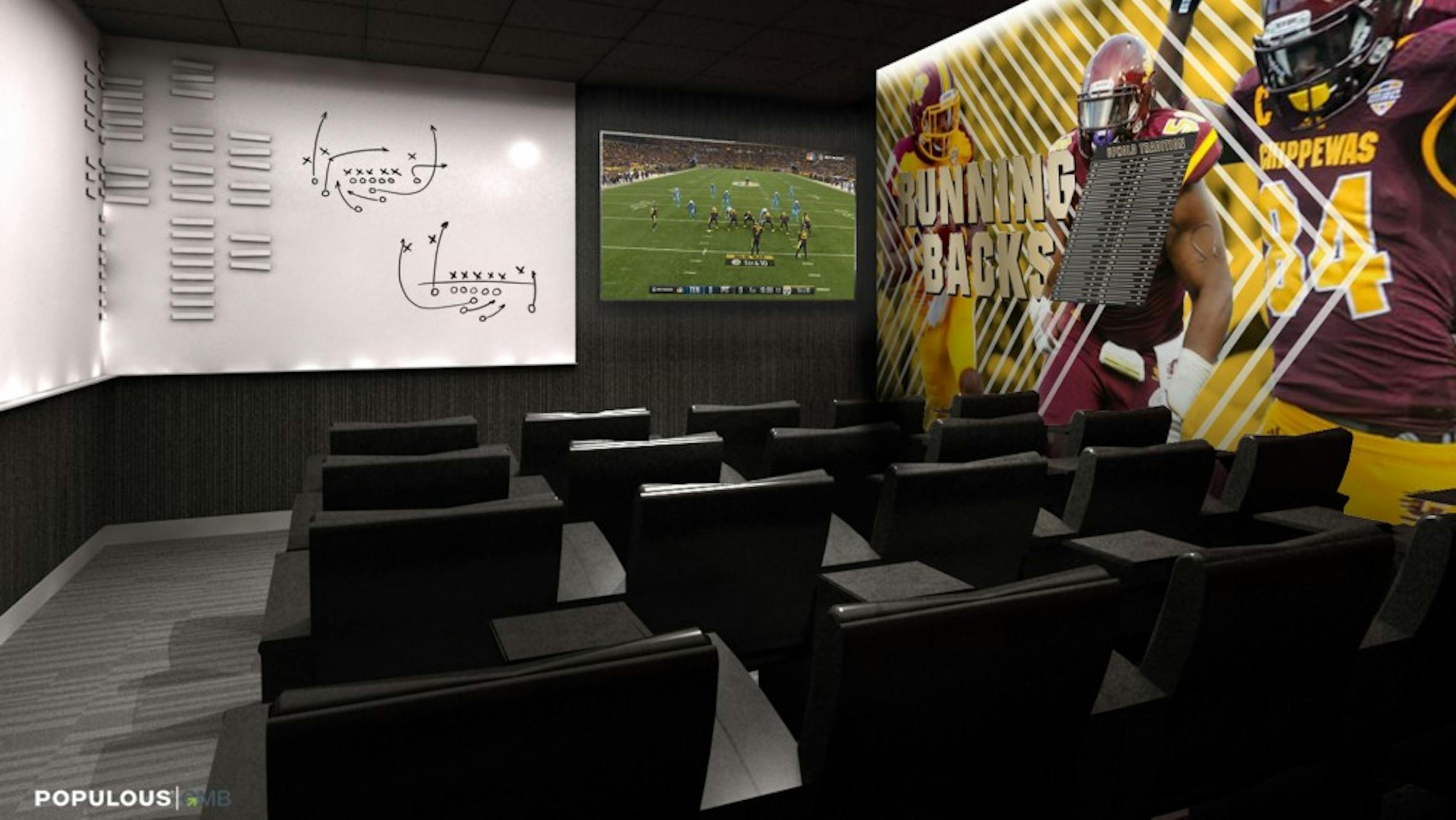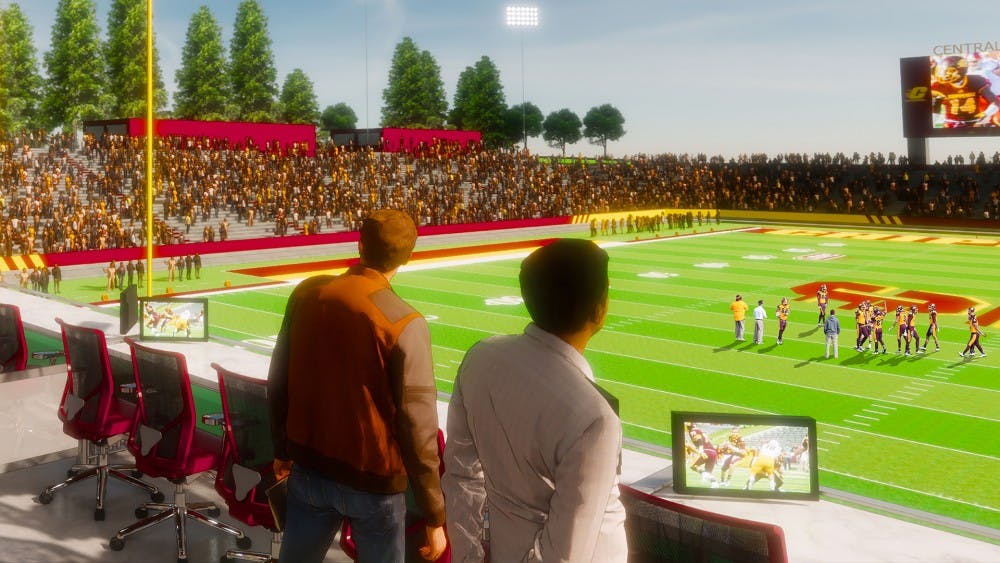Athletics releases updated renditions for Chippewa Champions Center
The Central Michigan Athletic Department is calling it a "bold step forward" for the university.
An updated vision for the Chippewa Champions Center was released Friday afternoon, and it includes the planned interior features for the $32.5 million building.
"Facilities like the Chippewa Champions Center not only help us to develop the young men and women on our campus, but attract the next generation of student-leaders to CMU," said CMU President Robert Davies said in a press release.
There was no announcement from CMU Athletics of the fact that the project was scaled back and redesigned after the cost was expected to go $7 million over budget.
The building is dedicated to the student-athlete experience, CMU Athletics said. Of the 62,240-square-foot structure, there will be a 7,000-square-foot human performance center for student-athletes.
"I want to thank our Board of Trustees for making this project a reality, not just for Athletics, but for the entire university," said Director of Athletics Michael Alford. "I also appreciate the support of our donors and campus partners because without their trust and investment in this project, it would not be possible."
An expanded sports medicine and rehabilitation facility with hydrotherapy pools are also set to be implemented for the players.
Two pre- and post-workout nutrition stations will be accessible to all CMU athletes. There's an expected auditorium and 7,100-square-feet of office and meeting space.
CMU football's locker room will occupy 4,200-square-feet, along with an equipment, laundry and video operations room.
"Building a facility like the Chippewa Champions Center is tangible proof to those parents and future Chippewas that Central Michigan University is serious about investing in developing student-athletes," said first-year football coach Jim McElwain, who was the head coach at Florida from 2015-17.

The Champions Center features two different options to watch football games.
The loge boxes doubles as a traditional club area and private suite, allowing fans to watch from outside and indoors. There are 16 loge boxes set to be implemented.

The Isabella Bank Field Level Club, which will be located near the team's locker room, features an indoor clubroom inside the Champions Center. However, the 4,000-square-foot viewing spot also has an outdoor patio directly behind the north end zone. Fans can watch the game from either location.
To bring the non-student-athlete experience into the building, CMU Athletics has announced the Champions Center will provide training opportunities for those enrolled in the College of Health Professions and College of Medicine.
The Champions Center also gives students pursuing marketing, hospitality, broadcast and public relations degrees with a chance to work in the facility, the Athletic Department said.

When CMU Athletics announced the original design for the Champions Center, it was a three-story project. Since then, the third-floor was wiped due to budgetary reasons.
The third floor was expected to hold offices for administrators in the Advancement Department, but that is no longer the case.
President Robert Davies told Central Michigan Life the reason for the pullback was due to economic changes over the past year.
If the building would've remained three floors, the cost was expected to increase by $7.1 million.
Here are new pictures of the Chippewa Champions Center's interior:






Davies, Alford, McElwain, women's basketball coach Heather Oesterle and former CMU Board of Trustees member Bill Kanine commented on the Chippewa Champions Center in the press release.
Davies: "Since I arrived at Central Michigan University, I've told every coach and administrator in our athletics department that my goal for our student-athletes is simple—a ring on one hand and a diploma in the other. Our responsibility as a university community is to create the conditions to help make this possible. Facilities like the Chippewa Champions Center not only help us to develop the young men and women on our campus, but attract the next generation of student-leaders to CMU. It's the kind of project that's positive impact reverberates across our campus and is nothing short of a game-changer for our university."
Alford: "I want to thank our Board of Trustees for making this project a reality, not just for Athletics, but for the entire university. I also appreciate the support of our donors and campus partners because without their trust and investment in this project, it would not be possible. Investing in student-athlete success is at the core of our mission as an athletics department and it's really what the Chippewa Champions Center is all about."
McElwain: "When I sit in a living room and talk to parents, I look them in the eye and tell them that our top priority is helping their son become the best version of himself. Building a facility like the Chippewa Champions Center is tangible proof to those parents and future Chippewas that Central Michigan University is serious about investing in developing student-athletes. As coaches, we're motivated by the ability we have to positively impact the lives of the young men and this facility will greatly enhance our ability to do so."
Oesterle: "Whether you're building a culture of excellence within a basketball program or trying to move a university forward, it requires universal buy-in. The Chippewa Champions Center is the kind of project that will impact each one of our programs. The sport medicine and student-athlete development spaces elevate the experience of all our student-athletes. Our entire athletics department is on-board with this game-changing facility."
Kanine: "You've got to promote the opportunity to give students whatever we can for them to be the best they can be. That's not just athletics, that's about the students. That's all going to be a positive with investing in the Chippewa Champions Center. As important as Advancement is now, it's going to be more important in the future. We have to go out to recruit, and the people we help now are going to help us later."






